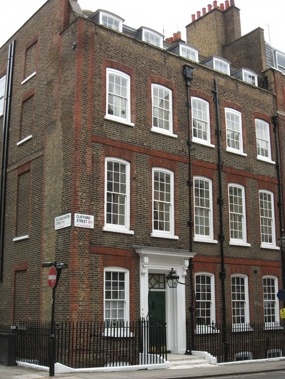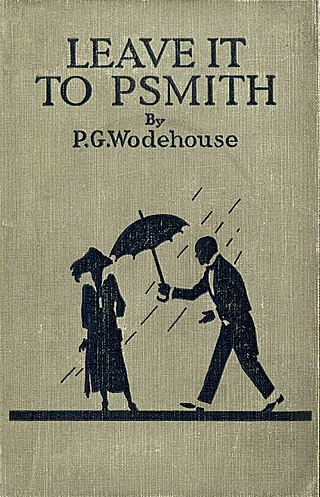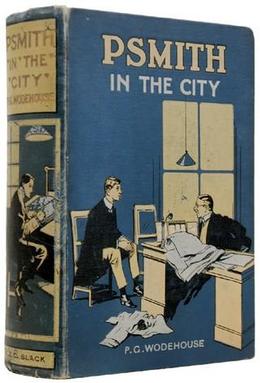
Sir Pelham Grenville Wodehouse, was an English writer and one of the most widely read humorists of the 20th century. His creations include the feather-brained Bertie Wooster and his sagacious valet, Jeeves; the immaculate and loquacious Psmith; Lord Emsworth and the Blandings Castle set; the Oldest Member, with stories about golf; and Mr Mulliner, with tall tales on subjects ranging from bibulous bishops to megalomaniac movie moguls.

The Drones Club is a recurring fictional location in the stories of British humorist P. G. Wodehouse. It is a gentlemen's club in London. Many of Wodehouse's Jeeves and Blandings Castle stories feature the club or its members.
Blandings Castle is a recurring fictional location in the stories of British comic writer P. G. Wodehouse, being the seat of Lord Emsworth, home to many of his family and the setting for numerous tales and adventures. The stories were written between 1915 and 1975.
Clarence Threepwood, 9th Earl Emsworth, commonly known as Lord Emsworth, is a recurring fictional character in the Blandings Castle series of stories by British comic writer P. G. Wodehouse. He is the amiable and somewhat absent-minded head of the large Threepwood family. Longing for nothing more than to talk to his prize pig, Empress of Blandings, or potter peacefully in the idyllic gardens of Blandings Castle, he must frequently face the unpleasant reality of his domineering sisters and familial duties.
Sebastian Beach is a fictional character in the Blandings stories by P. G. Wodehouse. He is the butler at Blandings Castle, seat of Lord Emsworth and his family, where he serves for over eighteen years.
Rupert J. Baxter is a fictional character in the Blandings stories by P. G. Wodehouse. Often called the Efficient Baxter, he is Lord Emsworth's secretary, and an expert on many things, including Egyptian scarabs. He invariably wears his rimless spectacles, suspects everyone of being an impostor, and is, as his epithet suggests, extremely efficient.
The Honourable Frederick Threepwood is a fictional character in the Blandings stories by P. G. Wodehouse. A member of the Drones Club affectionately known as "Freddie", he is the second son of Lord Emsworth, and a somewhat simple-minded youth who brings his father nothing but trouble.

Leave It to Psmith is a comic novel by English author P. G. Wodehouse, first published in the United Kingdom on 30 November 1923 by Herbert Jenkins, London, England, and in the United States on 14 March 1924 by George H. Doran, New York. It had previously been serialised, in the Saturday Evening Post in the US between 3 February and 24 March 1923, and in the Grand Magazine in the UK between April and December that year; the ending of this magazine version was rewritten for the book form.

Rupert Psmith is a recurring fictional character in several novels by British author P. G. Wodehouse, being one of Wodehouse's best-loved characters.

Psmith in the City is a novel by P. G. Wodehouse, first published on 23 September 1910 by Adam & Charles Black, London. The story was originally released as a serial in The Captain magazine, between October 1908 and March 1909, under the title The New Fold.

Mike Jackson is a recurring fictional character in the early novels by British comic writer P. G. Wodehouse, being a good friend of Psmith. He appears in all the Psmith books.
Lady Constance Keeble is a recurring fictional character in the Blandings Castle stories by British comic writer P. G. Wodehouse, being Lord Emsworth's most formidable sister, a strikingly handsome woman, with a fair, broad brow, and perfectly even white teeth. She has the carriage of an empress, and her large grey eyes are misleadingly genial.

Belle of the Nineties is a 1934 American Western film directed by Leo McCarey and released by Paramount Pictures. Mae West's fourth motion picture, it was based on her original story It Ain't No Sin, which was also to be the film's title until censors objected. Johnny Mack Brown, Duke Ellington, and Katherine DeMille are also in the cast. The film is noted for being the premiere performance of the jazz standard "My Old Flame", performed by West with the Duke Ellington Orchestra.

Brother Alfred is a 1932 British comedy film directed by Henry Edwards and starring Gene Gerrard, Molly Lamont and Elsie Randolph. It is based on the 1913 play of the same title by P.G. Wodehouse and Herbert Westbrook. It was shot at the Elstree Studios of British International Pictures. The film's sets were designed by the art director David Rawnsley.

Joy Ride is a 1935 British comedy film directed by Harry Hughes and starring Gene Gerrard, Zelma O'Neal and Betty Ann Davies. The film was made at the Nettlefold Studios in Walton. The film's art direction was by Don Russell.

Lucky Girl is a 1932 British musical comedy film directed by Gene Gerrard and Frank Miller and starring Gerrard, Molly Lamont and Gus McNaughton. It was made at Elstree Studios with sets designed by the art director John Mead. It was based on a play titled Mr. Abdullah.
Rolling Home is a 1935 British comedy film directed by Ralph Ince and starring Will Fyffe and Molly Lamont. It was made at Shepperton Studios.
It's in the Blood is a 1938 British comedy film directed by Gene Gerrard and starring Claude Hulbert, Lesley Brook and Max Leeds. It was made at Teddington Studios by the British subsidiary of Warner Brothers.
Leave it to Psmith, subtitled "A comedy of youth, love and misadventure", is a 1930 comedy play by Ian Hay and P. G. Wodehouse, based on the latter's 1923 novel of the same title. It premiered in London's West End at the Shaftesbury Theatre on 29 September 1930.










